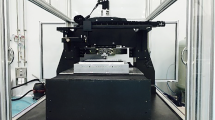Abstract
Tool wear is a key factor affecting machined surface quality; numerous methods have been adopted to reflect tool wear features online. In the present research, workpiece modal frequencies were employed to present tool wear level in ultra-precision raster fly cutting (UPRFC) process. In time domain, cutting force composition and the relation between cutting force amplitude and tool wear level were explored. In frequency domain, the relation between workpiece modal frequencies as a response of cutting force stimulus and tool wear level was investigated. Theoretical and experimental results reveal that the peak power spectrum density (PSD) values of the workpiece modal vibration (especially the first order workpiece modal vibration) grow with the progress of tool wear, the width of flank wear land and the first order workpiece modal vibration has a linear relationship, which could be used to predict tool wear in UPRFC and even other intermittent cutting process.
Similar content being viewed by others
References
Zhang SJ, To S, Zhang GQ (2017) Diamond tool wear in ultra-precision machining. Int J Adv Manuf Technol 88(1):613–641
Nabil BF, Mabrouk M (2006) Effects of random aspects of cutting tool wear on surface roughness and tool life. J Mater Eng Perform 15(5):519–524
Attanasio A, Ceretti E, Rizzuti S, Umbrello D, Micari F (2008) 3D finite element analysis of tool wear in machining. CIRP Ann Manuf Technol 57(1):61–64
Luo X, Cheng K, Holt R (2003) Modelling and simulation on the tool wear in nanometric cutting. Wear 255(7–12):1427–1432
Ozgedik A, Cogun C (2006) An experimental investigation of tool wear in electric discharge machining. Int J Adv Manuf Technol 27(5):488–500
Shahabi HH, Ratnam MM (2008) On-line monitoring of tool wear in turning operation in the presence of tool misalignment. Int J Adv Manuf Technol 38(7):718–727
Saglam H (2011) Tool wear monitoring in bandsawing using neural networks and Taguchi’s design of experiments. Int J Adv Manuf Technol 55(9):969–982
Cheng K, Huo D (2013) Micro cutting: fundamentals and applications. John Wiley & Sons, Chichester
Lin SC, Ting CJ (1995) Tool wear monitoring in drilling using force signals. Wear 180(1):53–60
Huang SN, Tan KK, Wong YS, De Silva CW, Goh HL, Tan WW (2007) Tool wear detection and fault diagnosis based on cutting force monitoring. Int J Mach Tools Manuf 47(3):444–451
Ravindra HV, Srinivasa YG, Krishnamurthy R (1993) Modelling of tool wear based on cutting forces in turning. Wear 169(1):25–32
Yen CL, Lu MC, Chen JL (2013) Applying the self-organization feature map (SOM) algorithm to AE-based tool wear monitoring in micro-cutting. Mech Syst Signal Process 34(1):353–366
Hocheng H, Kuo KL (2002) On-line tool wear monitoring during ultrasonic machining using tool resonance frequency. J Mater Process Technol 123(1):80–84
Salgado DR, Alonso FJ (2007) An approach based on current and sound signals for in-process tool wear monitoring. Int J Mach Tools Manuf 47(14):2140–2152
Cuppini D, D'errico G, Rutelli G (1990) Tool wear monitoring based on cutting power measurement. Wear 139(2):303–311
Al-Sulaiman FA, Baseer MA, Sheikh AK (2005) Use of electrical power for online monitoring of tool condition. J Mater Process Technol 166(3):364–371
Salgado DR, Alonso FJ (2006) Tool wear detection in turning operations using singular spectrum analysis. J Mater Process Technol 171(3):451–458
Malekian M, Park SS, Jun MB (2009) Tool wear monitoring of micro-milling operations. J Mater Process Technol 209(10):4903–4914
Nouri M, Fussell BK, Ziniti BL, Linder E (2015) Real-time tool wear monitoring in milling using a cutting condition independent method. Int J Mach Tools Manuf 89:1–13
Ghosh N, Ravi YB, Patra A, Mukhopadhyay S, Paul S, Mohanty AR, Chattopadhyay AB (2007) Estimation of tool wear during CNC milling using neural network-based sensor fusion. Mech Syst Signal Process 21(1):466–479
Li W, Gong W, Obikawa T, Shirakashi T (2005) A method of recognizing tool-wear states based on a fast algorithm of wavelet transform. J Mater Process Technol 170(1):374–380
Jiang CY, Zhang YZ, Xu HJ (1987) In-process monitoring of tool wear stage by the frequency band-energy method. CIRP Ann Manuf Technol 36(1):45–48
Zhang G, To S, Xiao G (2014) Novel tool wear monitoring method in ultra-precision raster milling using cutting chips. Precis Eng 38(3):555–560
Zhang G, To S, Xiao G (2014) The relation between chip morphology and tool wear in ultra-precision raster milling. Int J Mach Tools Manuf 80–81:11–17
Zhang G, To S (2016) An in-process tool wear evaluation approach for ultra-precision fly cutting. Int J Adv Manuf Technol 86(1):1–9
Zhang G, To S, Xiao G (2014) A novel spindle inclination error identification and compensation method in ultra-precision raster milling. Int J Mach Tools Manuf 78:8–17
To S, Zhang G (2014) Study of cutting force in ultra-precision raster milling of V-groove. Int J Adv Manuf Technol 75(5–8):967–978
Zhang G, To S, Zhang S (2016) Relationships of tool wear characteristics to cutting mechanics, chip formation, and surface quality in ultra-precision fly cutting. Int J Adv Manuf Technol 83(1–4):133–144
Yellowley I (1985) Observations on the mean values of forces, torque and specific power in the peripheral milling process. Int J Mach Tool Des Res 25(4):337–346
Drescher JD (1991) Tool force, tool edge and surface finish relationships in diamond turning: [PhD dissertation]. North Carolina State University, Raleigh
Lee WB, Cheung CF (2003) Surface generation in ultra-precision diamond turning: modelling and practices. John Wiley & Sons
Author information
Authors and Affiliations
Corresponding author
Rights and permissions
About this article
Cite this article
Zhang, G., To, S. Relation between tool wear and workpiece modal vibration in ultra-precision raster fly cutting. Int J Adv Manuf Technol 93, 3505–3515 (2017). https://doi.org/10.1007/s00170-017-0777-0
Received:
Accepted:
Published:
Issue Date:
DOI: https://doi.org/10.1007/s00170-017-0777-0



